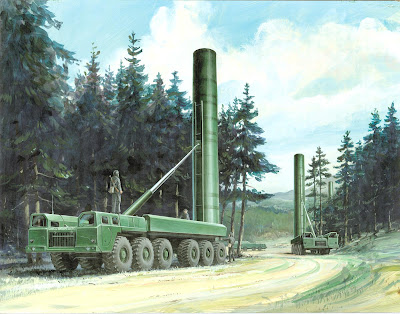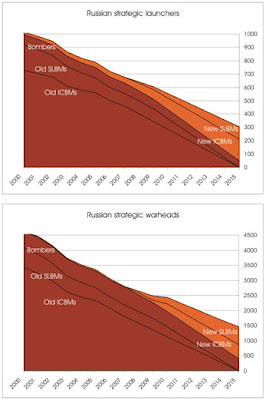Thursday Roll-up of Missile News and Notes: РоÑÑийÑкий ВыпуÑк (Russian Edition)
 Another average week…the Iranians started it off by claiming to have launched their SLV, but then, no, wait, it was just a sounding rocket (some think it was nothing more than a Scud B shot straight up which would have yielded the 150 km altitude claimed). Fallout from China’s ASAT test continued in the wake of critical comments delivered from many nations at the Conference on Disarmament held a couple of weeks ago – so much so that China now says they will not conduct any new ASAT tests. And of course, Russia keeps up the steady drumbeat of angst over the US plan to base a portion of the Ballistic Missile Defense System (BMDS) in Poland and the Czech Republic. Seizing on the INF as a bat to brow beat Europe, and in particular, those states that constituted Eastern Europe under Soviet domination and occupation, into opposing the deployment with thinly veiled threats of re-opening IRBM/MRBM production lines (particularly of the notorious SS-20/RDS-10 “Pioneerâ€) and targeting those countries that would host BMDS elements. In his travels to and fro the ‘sphere researching these and other news items, YHS has come across a few gems to share with you today.
Another average week…the Iranians started it off by claiming to have launched their SLV, but then, no, wait, it was just a sounding rocket (some think it was nothing more than a Scud B shot straight up which would have yielded the 150 km altitude claimed). Fallout from China’s ASAT test continued in the wake of critical comments delivered from many nations at the Conference on Disarmament held a couple of weeks ago – so much so that China now says they will not conduct any new ASAT tests. And of course, Russia keeps up the steady drumbeat of angst over the US plan to base a portion of the Ballistic Missile Defense System (BMDS) in Poland and the Czech Republic. Seizing on the INF as a bat to brow beat Europe, and in particular, those states that constituted Eastern Europe under Soviet domination and occupation, into opposing the deployment with thinly veiled threats of re-opening IRBM/MRBM production lines (particularly of the notorious SS-20/RDS-10 “Pioneerâ€) and targeting those countries that would host BMDS elements. In his travels to and fro the ‘sphere researching these and other news items, YHS has come across a few gems to share with you today.
We begin with a guest editorial from Mikhail Baranov, science editor, Arms Export magazine as it appears in Kommersant (“Businessmanâ€) which advertises itself as Russia’s Daily Online, under the heading of “Short-sighted Midrange Rockets.†In the article, Baranov takes current Russian leadership to task for recent statements regarding withdrawing from the INF treaty and deploying “a new SS-20.†Clearly he sees this move as anything but in Russia’s best interest:
“Russian politicians and generals are apparently in the thralls of nostalgia for the horror that embraced NATO 30 years ago after Pioneers were placed along the Western borders of the Warsaw Pact countries. The obvious assumption is that the Eastern European countries, frightened by Russian short- and midrange missiles aimed in their direction, will prefer good relations with Moscow to a dangerous and poorly defined alliance with Washington. It is also assumed that a wedge will be driven into relations between Western Europe on the one side and Eastern Europe and the U.S. on the other, with the Western Europeans being unwilling to tolerate the wrath of Russia because of the behavior of the Americans, Poles and Czechs.â€
“All of that looks illusory and extremely naive. If efforts to alienate Western Europe from the U.S. were fruitless in Soviet times, attempts by the militarily much-weakened “energy superpower†now will be dismissed completely by the European elite. Eastern
Europe will undoubtedly use the Russian missile threat for its own practical purposes. Finding themselves the frontline, at which the Russian “new SS-20s†are aimed, Poland
and the Czech Republic will justly be able to count on political and financial special treatment from their NATO allies.â€
One of the first effects he sees of such a move would be to speed the deployment and possible expansion of missile defense forces in Europe. That might be a little too linear thinking, but understandable in light of the West’s ultimate reaction to the deployment of the SS-20 by deploying upgraded theater nuclear forces (Pershing II’s and GLCM’s) in the early 80’s. The present system would be significantly challenged by technical features (e.g., penetration aids), numbers (threats vs numbers of ground-based interceptors or GBIs) and intercept windows (window of opportunity to conduct an intercept) when faced with a possible Russian MR/IRBM series of launches.
Baranov alludes to the above and posits that the next step would be a deployment of new, more precise and thereby more lethal than their Russian counterpart, MR/IRBMs or Pershings as he labels them. He is rather quick to note that
“…Russia has no midrange missiles even in the design stage, while the U.S. is actively developing them for submarine use. What would stop them from creating a land version of the same missile? The Americans have a clear advantage in midrange ship-base cruise missiles, which could also be easily adapted to land use.â€
Their military budget is $518 billion, our entire GDP is only twice as much as that, and yet here we are, withdrawing from the intermediate-range and shorter-range missile treaty. So that the Americans might not deploy a missile defense system in the Czech Republic but some resurrected Pershings.Question three: Chief of the General Staff Baluyevskiy said that we could retaliate by withdrawing from the intermediate-range and shorter-range missile treaty. I would remind you: This is the treaty that the huge USSR signed when it realized that it was unable to resist the US Pershings in Europe. Fine! The United States threatens us – and we withdraw from the intermediate-range and shorter-range missile treaty. Translated from the language of our strategists, they have tried to intimidate a hedgehog with their bare ass.
 Along with the website is a blog in the traditional sense. Again, the articles on the whole are balanced, thoughtful, technically rich and generally devoid of nationalistic bombast or propaganda. That is saved for the comments section which has its fair share of hard core Russian nationalists providing their input.
Along with the website is a blog in the traditional sense. Again, the articles on the whole are balanced, thoughtful, technically rich and generally devoid of nationalistic bombast or propaganda. That is saved for the comments section which has its fair share of hard core Russian nationalists providing their input.
Of particular note is the most recent posting is a quick analysis of force structure out to 2015. What is immediately apparent from the graphs (replicated here) is the impact of legacy missiles (SS-18, SS-19, etc.) and block obsolescence. He does note that he is assessing the Topol-Ms produced in the outyears to be a 3-MIRV model, something about which there has been much speculation in the open press, but no open declaration to do so, probably until START I expires in 2009. There is also an assumption that the problems plaguing the Bulava SLBM will be rectified and production and deployment resumed, albeit in a delayed manner, to offset the rapid retirement of old SLBMs and subs.
A good site with valuable insight and information – I’ve added it to my blogroll.
– SJS
